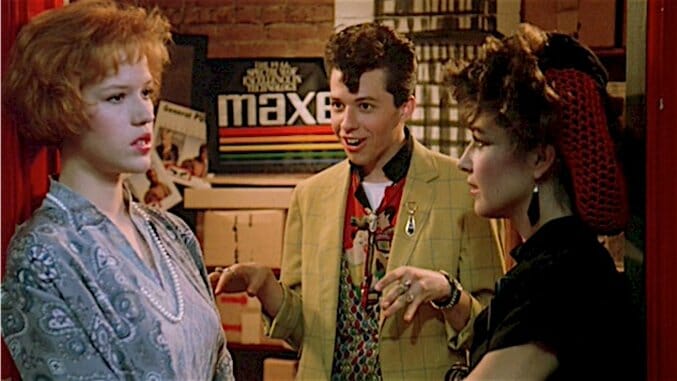“Now It’s Fading Fast…”: Introducing a Teen to the Teen Canon of the 1980s
Part 2: Pretty in Pink
Movies Features Pretty In Pink
My brother was appalled at my behavior. “What are you doing?” he demanded. “Let her find her own stuff. That’s awful.”
The awful thing I was doing was introducing my 14-year-old (herein known as “Grace”) to the teen film classics of my own teen years. “Let her find her own stuff?” I retorted. “Like I could stop her?” Grace knows more YouTube personalities than I ever will, and has been talking about bands and books and films and comics I’ve never heard of since she was nine. But I was curious: Would a kid born in 2002 be able to relate to the teen pop-culture of my own teen years? I brushed aside some uncomfortable memories of watching American Graffiti with my dad for the fifth time and offered her The Breakfast Club. At the time of writing this, it remains her favorite film of all time.
Clearly there was something there. So, with a little trepidation-not because I was foisting something on Grace but because I wasn’t sure what nasty little nostalgia ghosts it might unleash for me-I opened the Pandora’s Jar that is Pretty in Pink. Technically Howard Deutsch directed this one, but in most ways (writer, producer, soundtrack-genius) it’s really John Hughes’s film.
“Oh, yay, Molly Ringwald!” Grace exclaimed. “Is Ally Sheedy in this one, too?” (Grace had found a “Which Breakfast Club Character Are You? Buzzfeed quiz that confirmed that Sheedy’s Pixie-Stick-Sandwich-Eatin’ Allison Reynolds was her spirit animal.)
“Better. Harry Dean Stanton.”
“Who?”
Aside from Stanton’s face, which is so devastatingly expressive it could reasonably be classified as a munition, what I remembered most about Pretty in Pink was the iconic New Wave soundtrack. We all listened to it until our little 1980s cassette decks overheated. I think I knew one person who didn’t have a copy. You know how songs can permanently affix themselves to certain moments in time? That. Play OMD’s pop beauty “If You Leave” (which the band recorded ad hoc for Hughes on like 24-hours notice, or so they say). Immediate transport to the summer I turned thirteen, first kiss, first high school dance, a certain waxing moon over a certain terrace … but I digress. I knew the songs held up. Beyond that, I dimly recalled an us-them high school romance in a world where working class kids and country club brats all took their shit to extremes I reckon I was lucky to be able to deem unrealistic. Mannered and a little manipulative, not very deep, some good moments. That was what I remembered.
Pretty In Pink isn’t The Breakfast Club. It is, in fact, mannered, and a little manipulative and not very deep. Hughes wouldn’t pass anyone’s acid test on dealing with race, but he was genuinely interested in how class divide plays out in coming-of-age narratives, and in most of his movies there are tensions between the spoiled super-privileged and the scrappy and constantly shit-upon wrong-side-of-tracks kids. He handles it in a big, writ large, very overdramatized way, but overdramatized and writ large are food and drink to adolescents, and at least this film provided a teen-friendly gateway to thinking about what you have, and what’s important. His rich kid characters are absurdities—I went to high school with some seriously wealthy kids and none of them would have been caught dead dressing or acting like James Spader in that film. (What is up with the white suit?) His poor kid characters are largely just a little too put upon and noble. No one’s claiming Pretty in Pink is an artistic triumph, though Molly Ringwald and Harry Dean Stanton turned in really damn good performances, and I have to give supporting-character props to the chameleon Annie Potts. (Annie, your Kate Bush look was adorbs!) And Jon Cryer, as Ringwald’s indefatigable suitor who basically glues the film together singlehandedly, deserves eternal glory for the lip-synch dance scene in that record store. Some aspects of Pretty In Pink are pretty-forgettable, but that scene is a national treasure.
So, yeah, come for the soundtrack and stay for the super-cliffhanger “will the country club love interest have the nads to think for himself and choose the scruffy girl who makes her own clothes?” (Duh.) It has a sappy ending. It’s predictable and not just because I’d seen it before. It has some flashes of genius.
But at one point Grace said something to me that gave me a jolt. “The ’80s were like the last … I don’t know, the last optimistic generation, weren’t they?”
I asked what she meant by that. I was eight when Ronald Reagan was elected. I grew up in the Greed Is Good era, the end-times of the Cold War; I was taught what Mutually Assured Destruction was when I was in fourth grade and a lot of people were pretty sure ICBMs would be launched at us any minute. Not to mention all those stirrup pants and shoulder pads.
“Well, I mean—people still had faith that they could overcome their differences, and make their lives better if they were brave enough to try.”
And I think that’s roughly the point at which my heart just broke.
Mom Rating: 7.5
Snarky Teen Rating: 8.5 (almost exclusively for Jon Cryer’s lip-synch performance.)